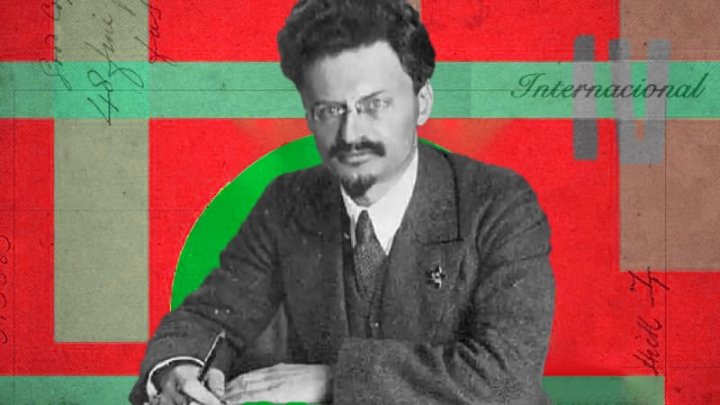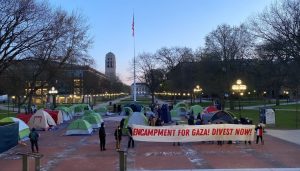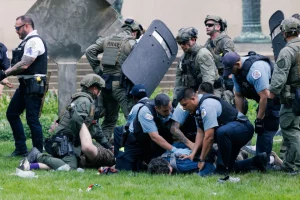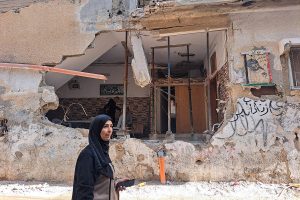The following is a speech given by Paul LeBlanc at the Second Leon Trotsky International Meeting, which took place in Sao Paulo, Brazil on August 21-25. The goal of the conference is to discuss the ideas and relevance of Leon Trotsky for leftists today. This speech was given on a panel about Trotskyism around the world.
*
Before engaging in this brief survey of Trotskyism in the United States, I will offer three pieces of context. The survey will focus on shortcomings that undermine the ability of U.S. Trotskyism to live up to its potential as an effective political force. I will conclude with possible solutions.
Contextual Piece #1: We seem to be in a period of transition. Just as three decades ago we transitioned from the Cold War Era to the Age of Globalization, we now seem to have entered an age of crisis, chaos, and unraveling. The structure and dynamics of the global economy generate deepening inequalities, instabilities, and destructiveness that throw into question the future of human civilization. This has been accompanied by a sharp tilt to the right by a significant section of the ruling class but also within the larger population – although this is fiercely resisted by many others among that larger population. The right-wing extremism of Donald Trump is only one manifestation of a larger, deeper trend. The eroding quality of life for more and more of the world’s laboring majorities is matched by growing authoritarianism, irrationality, and violence.
Most serious of all, however, is an imminent threat to the survival of humanity: a voracious market economy designed to further enrich incredibly wealthy elites is intimately connected with the immense environmental destruction engulfing our world. The cascading environmental catastrophe – which has already begun – must be a central focus for serious revolutionaries, a matter to which we will return at the conclusion of these remarks.
Contextual Piece #2: There has been a deep erosion and partial collapse of the organized labor movement. The workers movement of the United States persists, in large measure, as a bureaucratic and largely ineffectual shell of what it once was. Related to this is a generalized disintegration and melting away of the traditional organized Left in the United States. This means amounts to a dramatic erosion of the organized source of practical political perspectives, accumulations of experience, and seasoned cadres and organizers.
In the late 20th century the two major currents on the Left were essentially reformist, entangled in the liberal capitalist Democratic Party. One was the social-democratic milieu, at the core of which was the Socialist Party. The other was the Stalinist and post-Stalinist milieu at the core of which was the Communist Party.
In addition, there was an array of independent Marxists, left-wing pacifists, Trotskyists and would-be Trotskyists, a once strong groundswell of Maoists, and successive waves of a very broad, somewhat nebulous, but vibrantly active “new left.” I think this multi-faceted array was given a coherence and weight largely because of its complex interrelationship with the larger working-class movement.
With the transition from the Cold War Era to the Age of Globalization, with the fading and erosion of the left-wing subculture grounded past experiences, and with the aging and falling away of cadres and organizers, the organizations of the traditional Left proved unable to renew and replenish themselves. They continue to exist, at best, as fragmentary remnants.
Contextual Piece #3: The present age of crisis, chaos, and unraveling has inevitably had a radicalizing impact on new layers of young people who are essentially part of a precarious but expanding working class. This has been reflected in the Occupy Wall Street insurgency, the Black Lives Matter insurgency, a multi-faceted women’s liberation insurgency, and in new manifestations of union organizing and strike actions. It has been reflected in the Bernie Sanders campaigns and other substantial electoral efforts to bring the socialist idea into the mainstream of U.S. politics, generally within the context of the Democratic Party. It has also been reflected in the substantial growth of Democratic Socialists of America (DSA) – with a paper membership of 100,000. Although deeply influenced by social-democratic reformism, DSA has been a magnet for a variety of radical currents. An important dimension of this radicalization, however, is the relative absence of experience, skills, and cadres associated with the left-wing subculture of previous times. This sometimes limits the effectiveness and durability of today’s efforts.
Here it is time to admit the limitations of my own experience. In the 1960s, I was part of the new left. In the early 1970s, I became part of the Trotskyist movement. For ten years I was active in the U.S. section of the Fourth International, the Socialist Workers Party (SWP) – at the time (with 2000 members) the largest and most effective Trotskyist organization whose continuity went back to the 1930s, the 1920s, and before. There were other split-offs and fragments identifying as Trotskyist – some were relatively sterile sects, others were better than that, but I have less information about them. In the 1980s, my membership ended when a wave of expulsions took place in the SWP, as its new leadership abandoned Trotskyism in an extreme adaptation to Castroism. Today it exists as a tiny, fairly irrelevant non-Trotskyist sect. After my expulsion, I gained experience with several fragments from the SWP – briefly in Socialist Action (today only a handful), then for several fruitful and enriching years in the modest Fourth Internationalist Tendency (never larger than 80 comrades, which formally dissolved in 1992), and finally for sixteen years of rather problematical experience in Solidarity, which never held on to more than 200 members at a time. In 2009 I decided to join what was at that time the largest and most vibrant Trotskyist formation in the United States, the thousand-member International Socialist Organization (ISO). I remained until it collapsed in 2019, largely under the weight of its own contradictions. Presently, I am a relatively inactive member of one of the post-ISO fragments, the Tempest Collective, and also of DSA (into which some of those fragments gravitated). I continue to identify with the Fourth International and maintain ties with the International Institute for Research and Education (headquartered in Amsterdam).
To review: The still-existing organizations, I have mentioned include: the ex-Trotskyist U.S. Socialist Workers Party (not more than 100 members); Socialist Action (not more than 50 members); Solidarity (not more than 200 members); and the Tempest Collective (not more than 100 members).
Three additional Trotskyist groups seem to me worthy of serious consideration. One, having perhaps 1000 members, is called Socialist Alternative, and is best known for electing and re-electing Kshama Sawant to city council in the city of Seattle. Another appears to be smaller, gathered around the online publication Left Voice, identifying with an entity called “Trotskyist Fraction – Fourth International,” which has significant member organizations in Latin America. A third is also small, Workers’ Voice (with a publication called Workers Action), created by a merger of Socialist Resurgence (a split-off from Socialist Action) and U.S. adherents of the International Workers League, a Trotskyist network also based in Latin American. I do not have sufficient knowledge about these groups.
There are at least ten more groups considering themselves Trotskyist, with memberships ranging from 10 to 100. A case can be made that some of these are more thoughtful and serious than others – but none of them can boast of any substantial political impact. These include: the Bolshevik Tendency, the Communist League of Revolutionary Workers (associated with the publication Spark), Freedom Socialist Party, the International Trotskyist Committee, the League for the Revolutionary Party, Socialist Organizer, Socialist Revolution, and the Socialist Workers Organization. Two entities self-identifying as “Trotskyist” – also with tiny memberships – have distinguished themselves with a particularly toxic sectarianism. One is the Spartacist League, which has done some valuable archival work, but has little to show after six decades. The Socialist Equality Party (once known as the Workers League) is associated with an interesting website (the World Socialist Web) and has published a few valuable books – especially by the late Soviet dissident historian Vadim Rogovin – but also has little to show for itself after sixty years of existence.
One debilitating characteristic of most of these groups (shared with many would-be “Leninist” groups of Maoist or Stalinist persuasion) is the inclination of each to see itself as the revolutionary vanguard, or as the nucleus of a future revolutionary vanguard – as the custodian of the true revolutionary Marxist tradition, the truly correct politics, around which the future revolutionary party must be built if it is, in fact, going to be a revolutionary party.
This generates two problematical outcomes. One problematical outcome is that the organization’s leadership, and its internal political culture, function to preserve – by any means necessary – what is deemed the truly correct politics. This all-too-often cuts across the critical-mindedness, the openness, the creativity, and even the internal democracy that are essential for a truly revolutionary party. Another problematical outcome is that all-too-often – for the sake of revolutionary purity, and to ensure an uncorrupted revolutionary party of the future – the self-defined “vanguard” creates barriers between itself and what are perceived as politically flawed organizations, at the same time abstaining from building actual, effective mass struggles of workers and the oppressed.
For some groups that consider themselves Trotskyist – in the United States, but also in other places – the focus of comrades has, basically, been to develop revolutionary thoughts and articulate revolutionary “positions.” This can be done by arguing (to those who will listen) against the capitalist ruling class, or against non-revolutionary groups, or against other would-be revolutionary groups that have somewhat different thoughts and positions. Comrades discuss such matters at membership meetings, distribute the organization’s newspaper, staff literature tables, hold forums, and organize study groups. If rallies or demonstrations are to be organized, it is often done through auxiliary formations controlled by one’s own revolutionary organization. This adds up to the creation of one’s own small sectarian universe.
Several years ago, the late John Molyneux described a much healthier orientation preferred by Ireland’s Socialist Workers Network: “actual engagement with the everyday struggles of working people in workplaces, unions, communities and campaigns.” Molyneux explained that “this engagement cannot be just at the level of words, by means of the correct transitional program, etc. It has to be real, face-to-face, day-to-day.” He used an Irish expression to elaborate that “such interaction ‘puts manners on’ . . . both leaders and members. It creates a counter pressure to that exerted by capitalism and by reformist parties which rely on the passivity of the working class.” More than this, “it inhibits the sect mentality, deters an arrogant leadership (because rank and file comrades often feel more empowered to stand their ground on concrete immediate issues) and helps party members learn how to talk to working class people, not just each other. It breathes life into the stagnant pond of sect life.” This approach seems to me as applicable to the United States as to Ireland, but such an approach has not been the norm among U.S. Trotskyist organizations in the twenty-first century.
The possibility of a forward movement to socialism (or of a downward slide into barbarism), in my own country and many others, is being generated by the beginnings of a cascading climate catastrophe. To avoid the worst of such calamity, according to the United Nations International Panel on Climate Change (IPCC), global carbon emissions must be cut in half by 2030 and to zero by 2050. Global capitalism has generated this crisis. Some of its representatives have denied the crisis, and others have demonstrated a capacity for glowing rhetoric matched by phony compromises incapable of meeting the necessary goals.
Several years ago, British working-class Marxist Alan Thornett emphasized what should be common sense to any serious Marxist: “The environment is as much a working-class issue as wages, working conditions, or health and safety. It is not an add-on, an optional extra. The unavoidable reality is that in the end we can’t defend anything, or win anything, or build a socialist society, on a dead planet.” The impacts of growing environmental disasters will bring suffering and death to millions of people over the next several decades. This has a potential of jolting masses of people out of the ruts of passivity, apathy, and complacency.
The weak Trotskyist movement in the United States has not proved capable of providing leadership in the face of this reality. There is no effort to craft a transitional program addressing the present-day catastrophe in a manner that defends the interests of the working-class majority.
Analysts outside the Trotskyist movement, such as Naomi Klein, call for a Green New Deal which goes in this direction. “In tackling the climate crisis,” Klein argues, “we can create hundreds of millions of good jobs around the world, invest in the most systematically excluded communities and nations, guarantee health care and childcare, and much more. The result of these transformations would be economies built both to protect and regenerate the planet’s life support systems and to respect and sustain the people who depend on them.” This transitional approach combines multiple goals: people before profit, homes and good communities for all, health care for all, education for all, transit and communication systems for all, nourishing food for all, access to cultural and recreational nourishment for all, creative outlets for all, genuine liberty and real justice for all. Stemming from today’s conditions and from the consciousness of expanding layers of the world’s youth, and unalterably lead to a fundamental challenge to the existing system of power. It remains to be seen whether Trotskyists in the United States and beyond will be capable of meeting such a challenge.










